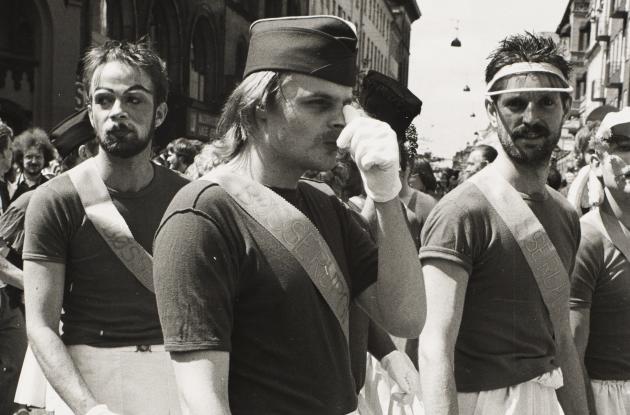Gay Liberation Front and Lesbian Movement
The active and visible struggle for rights really took off in the 1970s with campaigns, leaflets and not least the organisation of activists.
Until the 1970s, the struggle for rights in the LGBTI+ area was predominantly discreet or at least subdued, but the generally activist political environment and international currents of the 1970s led to a far more open struggle.
The Gay Liberation Front and the Lesbian Movement set a new socialist and feminist agenda for gay political activism in the early 1970s. Homosexuality at that time was still criminalised, ghettoised, and seen as perverted. Until 1976, for example, the age of sexual consent was higher for homosexuals, and until 1981, homosexuality was on the Danish Health Authority's list of mental illnesses.
The fight for rights
The inspiration for the more persistent form of activism came from the United States. The start of a whole new way of fighting for rights was seen in New York on 28 June, 1969 with a revolt against the brutal and continual police raids on the gay bar Stonewall Inn, located on Christopher Street in Greenwich Village, New York City. For several days, LGBTI+ groups and sympathisers were openly fighting against the police. Immediately after the riots, and as a result of them, the Gay Liberation Front was organised in the US. The first Gay Pride parade was a celebration of the events on Christopher Street, and the phenomenon gradually spread to other parts of the world.
Homoseksuel Aktion København, an opposition youth group in the Circle of 1948, already celebrated Christopher Street Day in 1970, and the Gay Liberation Front (in Danish: Bøssernes Befrielsesfront) was formed as an extension of the first official celebration in 1971.
The Lesbian Movement was founded in 1974. With the Gay Liberation Front out of the Circle of 1948, oppositional lesbians focused on the Rødstrømpe movement, which from its inception in 1970 had aligned itself closely with American second-wave feminism's hitherto unheard of criticism of capitalist male society's oppressive sexuality norms. The New York group Radicalesbians' manifesto "The Woman-Identified Woman" from 1969 had the same significance for lesbians as Christopher Street had for gay men.
The gays are here too
The handful of Gay Liberation Front pioneers originally called themselves "Gay Activists", and they were, in the spirit of the times, organised into grassroots groups without formal leadership. The policy was developed within the smaller groups, and at joint meetings the campaigns were planned and new members were admitted.
They started with come-out campaigns in Fælledparken. Here they sat down under the banner THE GAYS ARE HERE TOO and handed out leaflets about the Gay Liberation Front at afternoon concerts during the weekend, which attracted a large and young audience. They continued with dance campaigns at Rådhuspladsen in Copenhagen and in the hottest nightclubs at the time, announced on posters with the text: GAY SOLIDARITY, GAY POWER NOW! and GAYS COME OUT OF THE GHETTOS. The press was on the spot, and the first victory came when the ban on men dancing publicly with each other was lifted in 1973. And in the second half of the 1970s, they had nationwide gay caravans, which were later supplemented with gay island camps on islands like Agersø, Fejø and Ærø.
There had been pizazz over the Gay Liberation Front from the start. In 1975, the drama-educated Bent Jacobsen broke through with the critically acclaimed album "Bøsse" ("Gay"), which was played on all platforms. The following year, bestselling author Christian Kampmann signed up under the banner. The Gay Liberation Front gained a permanent foothold in the community centre Bøssehuset on Christania in Copenhagen and further developed it with a number of innovative sexually political music and theatre performances. Bøssehuset is still used by Danish LGBTI+ people today.
